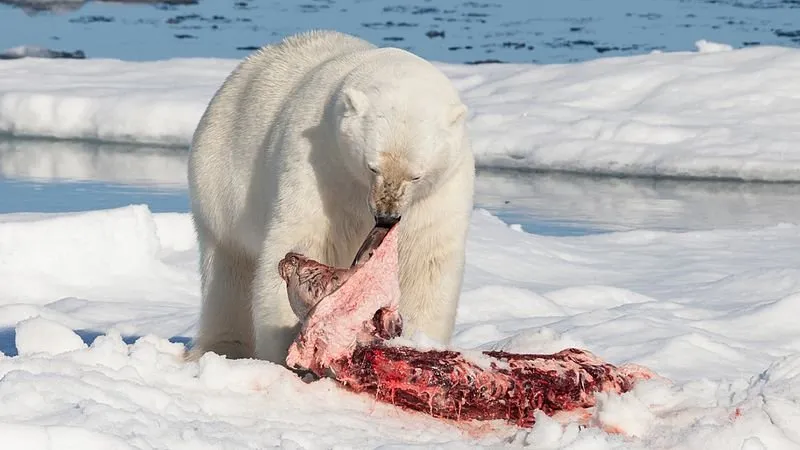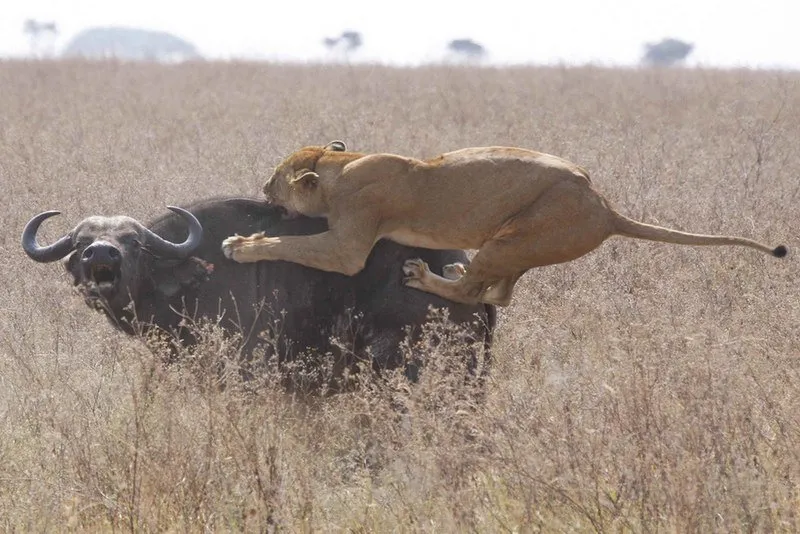
Polar bear
Source: Wikipedia, Author: AWeith, CC BY-SA 4.0
ok everyone, how are you doing today? on my last article, l promised to continue from where we stopped which was predation and competition
Now, Predation is another type of association between two organisms which are not of the same species in which the predator kills the other called the prey and directly feeds on it. Predation provides energy to prolong the life and promote the reproduction of the organism that does the killing. The predator which is usually larger in size and always stronger than the prey benefits by deriving it's food while the prey is completely eliminated thus reducing the number of individuals in the prey populations. Predator and prey population cycle through time, as predators declines the number of prey. As prey population advance, there is more food for predators. So, after a slight lag, the predator population increase as well. As the number of predators increase, more prey are captured.
Predators always search for prey or wait when they detected a prey, because they are more powerful and stronger than the prey, they'll kill and feed on the prey. Many predatory have sharp claws or jaws for gripping, killing and cutting up their prey. When a predator found prey, it must decide if to keep searching or to pursue it. This decision depends on the costs and benefits involved. Predators may consider the size of prey before deciding wether to pursue or keep searching.

lioness and cape buffalo
Source: Wikipedia, Author: Diamond Glacier Adventures, CC BY 2.0
Prey that is too small may not be worth the trouble for the amount of energy it provides, large prey may be difficult to capture. Lions can attack much larger preys including elephants but do so much less often. So predators have to consider these factors before they decide their next action.
Both vertebrate and invertebrate predator are adapted for hunting with acute senses such as vision, hearing or smell. Though predators rely heavily on their vision to find prey, there are some such as wolf, Fox and coyote which rely more on their Sense of smell other than vision.
Prey as well, rely on variety of sensory modes to detect these predators. Highly developed senses, warning signals and different defensive weapons and behaviors are all used by prey animals for survival. Some prey species are capable of fighting back against predator wether with chemicals like secretion of irritating liquid in the case of toad or secretion of offensive odour in the case of some beetles and bugs that secret offensive odour that can scares away their predators or enemies. Other animals can escape by fleeing rapidly or outrunning their predator.
Most carnivorous predators have many behavioral adaption which enables them to capture their prey, for example, the antlion digs a conical hole in the ground and waits at the bottom of the hole for the prey to fall in. The spider spins a web and waits for the prey to be caught in it. A lion or a leopard chases it's prey and overtakes it by speed, it catches the prey and kill it. The praying mantis remain in hiding, waiting for the prey to come within striking distance. Snakes also lay in ambush for their prey.
Examples of predation
The best known examples of predation involve carnivorous interaction.
- The hawk and chicks of fowls:
The hawk is the predator, because it is bigger and stronger than the chick, it kills and feed on the prey (young chicks) of domestic fowls. The hawk benefits while the chicks are completely eliminated. - Wolves hunting moose.
- Owls hunting mice
- Shrews hunting worms and insects.
- Snake and rat
- Sparrows catching insects to feed their young ones.
- Penguins catching fish under the ice
- Sharks stalking and killing other fish
- Bladderworts using negative pressure to suck prey into their bladders.
- Beers fishing salmon out of river.
Competition
Competition is a negative association between two organisms or species in which both the organisms are harmed. In the association, one organism outgrows the other and survives while the other can neither grow nor survives.
Competition stems from the fact that resources are limited. These limited resources can be short supply such as food, water, nutrients, gases, light and space. All organisms require these resources to grow, reproduce and survive.
During competition, one organization controls one or more of these resource which enable it to grow and survive while the other neither grow and survive leading to it's elimination.
When the competition is between members of the same species, it is called intra-specific competition while it is called inter-specific competition if it is between members of different species.
Intra-specific competition

Fighting flamingo
Source: Wikipedia, Author: Becks, CC BY 2.0
Intra-specific competition occurs when members of the same species compete for limited resources. This type of competition is a basic factor in natural selection. It leads to the evolution of better adaption within species.
Do you know why intra-specific competition is more intense?
It is because the individual is competing for exactly the same resources since they are in the same niche. Intra-specific competition is also known as survival of the fittest, because the better competitors will have a greater chance of surviving to reproduce and pass on their genes.
Some examples of intra-specific competition are:
- Two male birds of the same species competing for mates in the same area.
- A population of laboratory rats in a cage.
- A flock of domestic fowls in a deep litter house.
When organisms of two different species share a limiting resource in the same area, inter-specific will occur. When the resources cannot support both populations, lowered fecundity, growth or survival may result in at least one species. This type of competition can effect community and even influence the evolution of species as they adapt to avoid competition. This may result in the exclusion of a species in the habitat, niche separation and local extention. Inter-specific competition can play a role in sizing and shaping community structures.
Examples of intra-specific competition are:
1.Flowering plants and grasses:
This two different species compete for sunlight, nutrients and space, the flowering plant due to its size and numerous branches and leaves are capable of eliminating the grasses by depriving the grasses of nutrients, space and sunlight. The grasses may eventually be eliminated because they are not fitted for accessing these resources.
- Lion and leopard that vie for similar prey
- Woodpeckers and squirrels competing for nesting in the same holes and space in trees.
Now in conclusion, competition plays an important role in determining the pattern in which species succeed one another in a habitat!
Thanks again for reading my work 🙏
Permit me to stop here for now
Smile
Special thanks goes to @mobbs, @dexterdev, @cmplxty and @gentleshaid🙌
Being under their supervision has been amazing experience. Thank y'all for your supports.
James appreciates 💕